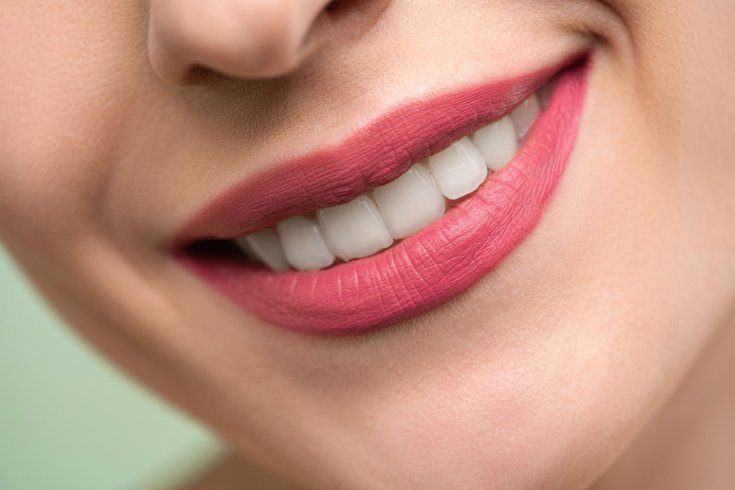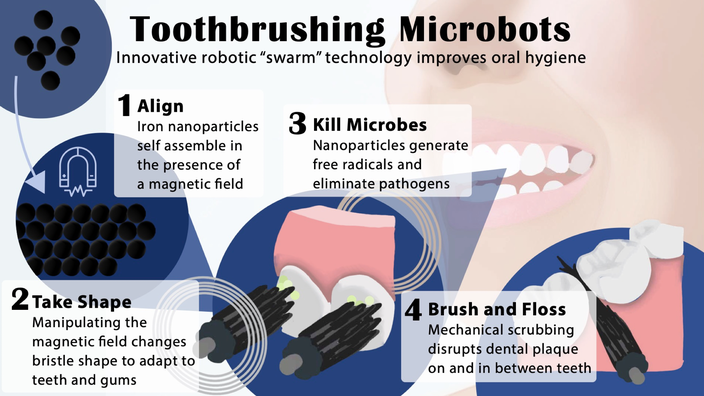
July 12, 2022
 Shiny Diamond/Pexels.com
Shiny Diamond/Pexels.com
The University of Pennsylvania's School of Dental Medicine is refining a new nanotechnology device that brushes and flosses teeth on its own.
Brushing and flossing your teeth may become a hands-off routine in the not-too-distant future, if researchers at the University of Pennsylvania have anything to say about it.
A team of engineers and experts at Penn's School of Dental Medicine have published a proof-of-concept study demonstrating how shapeshifting nanotechnology can be used to clean teeth and gums. These automated, robotic microswarms could reinvent a daily practice that has always been manual, and could simplify life for people who lack dexterity.
The nascent technology relies on iron oxide nanoparticles that can self-assemble, changing their motion and function using a combination of magnetic fields and catalytic reactions. The magic starts when the microbots are popped into the mouth in a fitted device. In one state, the microbots act as bristles that identify the contours of the teeth, stripping away dental plaque from their surfaces. In another state, they act as long strings that slip between the teeth to free gunk that's trapped in the gums.
The microbots also produce antimicrobials that kill bacteria in the mouth.
“Routine oral care is cumbersome and can pose challenges for many people, especially those who have hard time cleaning their teeth” Hyun Koo, a professor at Penn’s School of Dental Medicine, told Penn Today. “You have to brush your teeth, then floss your teeth, then rinse your mouth; it’s a manual, multistep process. The big innovation here is that the robotics system can do all three in a single, hands-free, automated way.”
Findings from a series of experiments using 3D-modeling and real people were published late last month in the journal ACS Nano. The study demonstrates surface topography-adaptive robotic superstructures (STARS) can offer a precision-guided approach to biofilm removal and diagnostic sampling.
“It doesn’t matter if you have straight teeth or misaligned teeth, it will adapt to different surfaces,” said Koo, a co-corresponding author on the study. “The system can adjust to all the nooks and crannies in the oral cavity.”
The infographic above explain's how Penn researcher's robotic swarm nanotechnology can be used to protect teeth and gums.
Koo and other researchers at Penn's Center for Innovation & Precision Dentistry began developing the technology several years ago after connecting with engineers who also were working with iron oxide nanoparticles. Other applications of the technology have been FDA-approved in contrast agents for MRIs and drug delivery systems. More broadly, nanoparticles have been used in a range of consumer and industrial products, from scratchproof eyeglasses to stain-repellant fabrics and crack-resistant paints.
The interdisciplinary team at Penn not only developed the kinetic basis for their oral care microbots, but worked on ways to enhance the cleaning capabilities of the device. Using catalytic reactions, for example, the microbots can activate hydrogen peroxide to release free radicals, which can kill bacteria that cause tooth decay and help degrade dental plaque biofilms.
The research, supported by Penn Health Tech and the National Institutes of Health’s National Institute of Dental and Craniofacial Research, is being refined to create a fully programmable system that can be tuned to the needs of each person's mouth.
The hope is that the technology can be deployed in clinical settings in the coming years.
“We’d love to see this helping the geriatric population and people with disabilities," Koo said. "We believe it will disrupt current modalities and majorly advance oral health care.”
It's doubtful these microbots will be hitting store shelves any time very soon — and when they do, they'll cost a fortune — but they could have real benefits to patients in some settings sooner than later.
 Melissa Pappas/Penn Engineering/Penn Today
Melissa Pappas/Penn Engineering/Penn Today